#A7V
Explore tagged Tumblr posts
Text
Footage of "Gretchen," Sturmpanzerwagen A7V No. 501. Gretchen was armed with only machine guns until fitted with a 57mm cannon in late 1918, and was ultimately abandoned in Sainte-Cécile, Belgium.
87 notes
·
View notes
Text

A7V German tank from WW1, only 20 were built and they were named by their crews. This one is called Hagen. There is only one original A7V left in the world, it's in a museum in Queensland, Australia. This photo was taken on the Horse Guards Parade, London, date unknown (1920s)
34 notes
·
View notes
Text

fixed up the A7V a bit, gonna move to something else now but i'll post something in perhaps two or so days. Besides that most by stuff was made because of the new war thunder update! it's alright though the Entente is a living hell sadly.. (wished they added the Renault-)
4 notes
·
View notes
Text
Leopard 2 A7v [ Heer ]
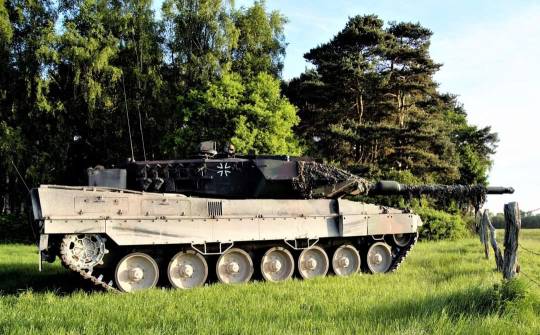
I love this picture.. 🖼
#love#real love#dream#my dreams#military#bundeswehr#bw#germany#flecktarn#panzer#tank#kampfpanzer#heer#leopard#leopard 2#a7v#ketten#sun#background#picture#beautiful#beauty#1500ps#v12#120mm#mylife#komandosoldat
2 notes
·
View notes
Text
Just wait until you learn about Gretchen, the German transgender tank.

Everyone ready for 1918's hottest new gender binary?
130 notes
·
View notes
Text
Starting this off with my favourite tank, the German Sturmpanzerwagen A7V!!
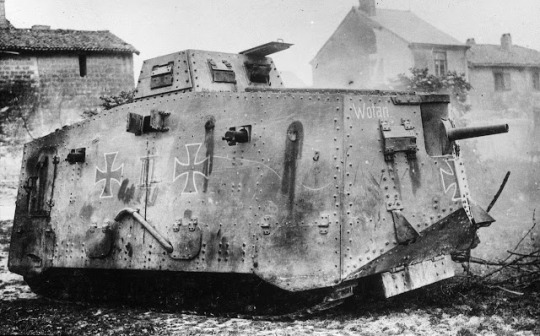
Why on earth is this chunky monstrosity my favourite tank out of every tank ever made? Because it is absolutely awful at everything and I think that's very funny.
The A7V was the first tank ever made by the Germans, it was invented in 1917 and used in the later stages of WW1. This thing was massive, measuring at about 8 metres long (26 feet), 3 metres wide (almost 10 feet), and 3.3 metres tall (almost 11 feet). It also weighed about 36 tons when in combat which caused a lot of problems, namely for its speed and traversal capabilities. Soldiers could outpace this thing ON FOOT. The A7V had a top speed of only 14 km/h (9 miles/h), which is already pretty slow, but that speed was drastically reduced if the terrain was even a little bumpy, going down to only 6 km/h (4 miles/h). And that was if this thing managed to not break down or get stuck in a shallow ditch. The Sturmpanzerwagen A7V was highly prone to suddenly failing due to the fact that the tank's track base was literally pulled out of a tractor. It was not a suitable base for a tank at all and made the whole thing unsafe in certain conditions, leading to frequent breakdowns. The A7V also had only a few inches of ground clearance. This meant that it had issues going over even a slight bump in the ground. It would also fall into ditches constantly. The overhanging and heavy front end meant that if it went over an edge even a little too far, there was no stopping it. Judging by the number of pictures of this thing getting stuck, this was a fairly common occurence.
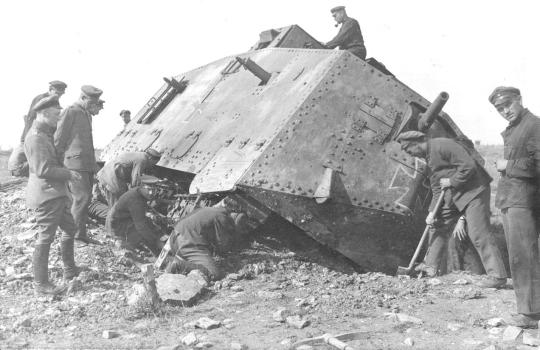
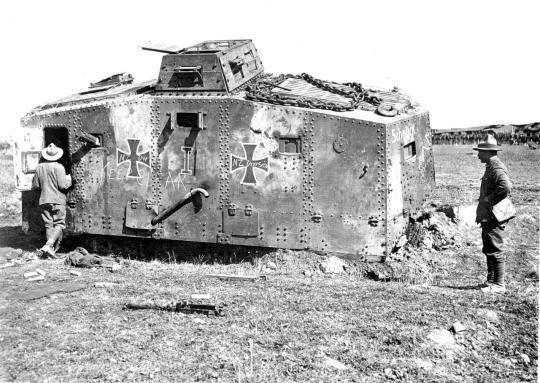
Let's not forget to mention that the driver of the A7V had a 10 meter long blindspot at all times. They were sat in that little box on top of the tank and had the front end of the tank blocking their view!! How anyone thought this was a good idea absolutely baffles me.

That's a lot of soldiers just to man one tank. This thing required a crew of 18 or more to operate, but due to its absolutely awful armour, none of them were safe!! The Sturmpanzerwagen A7V had near vertical armour plating, which made it highly susceptible to direct hits. Many tanks nowadays have angled plating for this exact reason, because vertical armour does not deflect bullets properly! Interestingly, the Sturmpanzerwagen A7V was one of the tanks involved in the first ever recorded tank on tank duel! On the 24th of April in 1918, three A7Vs went up against three Brittish Mk. IVs. The A7Vs lost of course. Brittish tanks, while still clunky, were much better than German tanks at this time.
Only twenty A7Vs were produced before WW1 ended. Many of them were either destroyed during the war, or scrapped afterwards due to their flawed design. Today only one Sturmpanzerwagen A7V remains, the 506 Mephisto, and it's in Australia of all places. The Mephisto was abandoned on the battlefield by its crew and later taken as a trophy by Australian soldiers. It now resides in the Queensland museum in Brisbane.
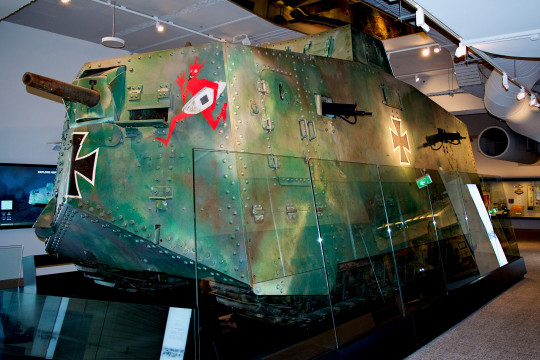
Sources: X , and my brain, I have this thing's history memorized.
#WW1#History#WW1 history#WW1 tanks#tankposting#tanks#tank#sturmpanzerwagen#sturmpanzerwagen a7v#german tanks
14 notes
·
View notes
Text

U.S. Marine convoy, from 1st Marine Division, at a halt during a sandstorm in Iraq. March 25, 2003.
88 notes
·
View notes
Text

Sturmpanzerwagen A7V. Yeah the motor is in the middle of the cab. You are IN the engine compartment. You ARE being slowly cooked.
*wakes up at 2am in a cold sweat* A7V toaster
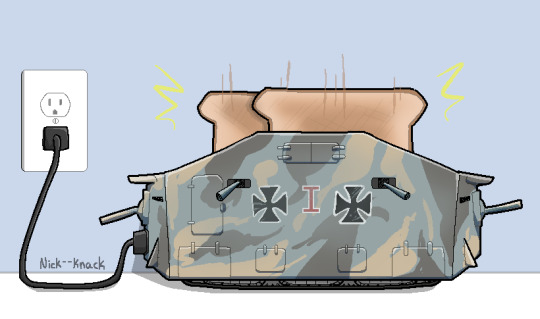
context:
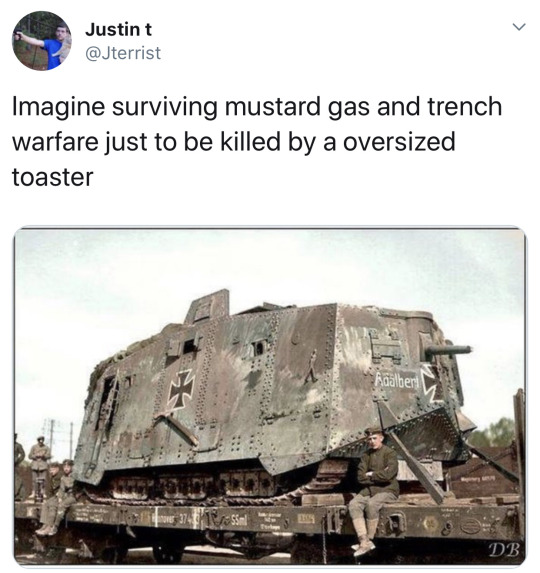
859 notes
·
View notes
Text

German WWI soldiers riding on a German A7V tank, France, May 1918. Only 20 were made and only one original remains, it's in Queensland, Australia
21 notes
·
View notes
Text

Just a quick sketch! been a bit busy irl so haven't got time to fix the shading or the background really but this will do, Tank in question is the A7V for the war thunder update (sad they didn't put the Renault though 😭) besides that, I'll fix this up and post another think sooner or later, cya!
5 notes
·
View notes
Text
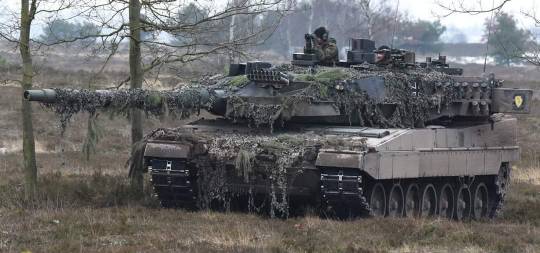
Leopard 2 A7V
#military#bundeswehr#bw#flecktarn#germany#panzer#tank#kampfpanzer#leopard#leopard 2#a7v#komandosoldat
1 note
·
View note
Text

La Deutsch Heer est le nom officiel de l’Armée de l’Empire Allemand entre 1871 et 1919. Elle est créée par le décret “Ordnung für Kriegsbundes Armee in Deutschland” ordonnée par Otto von Bismarck (1815-1898) alors Chancelier Impérial depuis 1871. “L’Oberste Heeresleitung” est le nom donné au haut-commandement de la Deutsche Heer et à sa tête se trouve l’Empereur Allemand (titre créé en 1871 et abrogé suite à la défaite allemande de 1918.) Entouré de ses proches qui forment l’État-major Particulier ; Les aides de camp, quatre officiers d’ordonnance, plusieurs officiers adjoints et deux médecins. Il y aura trois cabinets en place : Le Militätkabinett pour les affaires militaires, le Marinekabinett pour la marine et le Geheimes Zivilkabinett pour les affaires civiles. Ainsi les chefs de la Deutsche Heer sera du 18 Janvier 1971 au 9 Mars 1888, Guillaume 1er (1797-1888), du 9 Mars 1888 au 15 Mars 1888, Frédéric III (1831-1888) et du 15 Juin 1888 au 9 Novembre 1918, Guillaume II (1859-1941). Elle est alors constituée de vingt-cinq corps d’armée qui englobe 48 divisions d’infanterie, de cavalerie et d’artillerie confondue. Toutefois, après l’unification de l’Allemagne en 1871, l’armée allemande ne combat plus en Europe, mais sera active dans les colonies telles que lors de la Révolte des Boxers et se trouvera déployer partout où l’Empire Colonial Allemand est présent. Possédant ainsi une troupe coloniale du nom de “Schutztruppen” qui ne constituait pas un corps colonial autonome comparé à d’autres nations telles que la Légion Étrangère Française ou Espagnole, elle était même dépendante non pas du Ministère de la Guerre, mais des responsables et gouverneurs locaux. Ce n’est qu’en 1891 qu’apparaît là “Kaiserliche Schutztruppe für Deutsch-Ostafrika” sous l’impulsion du Commissaire et Colonisateur Allemand, Hermann von Wissmann (1853-1905). D’abord soumise à l’autorité de la Marine Impérial Allemande (Kaiserliche Marine) elle sera en 1896 suite à une loi, soumise au même titre que les troupes coloniales à l’autorité du Bureau Colonial Impérial (Reichskolonialamt). En termes d’opération, les troupes de Wissmann seront employées en 1891 contre les Héhé, durant la rébellion Maji-Maji (1905-1907), elle connaître le Siège de Tsingtau en 1914, puis quelque temps après, elle sera alors employé lors de la 1re guerre mondiale lors de la Campagne d’Afrique de l’Est (1914-1918).
Au sein même de l’Armée, une hiérarchie se dessine. Le Corps d’Officier est généralement recruté parmi les “Junkers”, propriétaire terrien prussien et donc, noblesse foncière du pays. Les Sous-officiers sont généralement des artisans instruits, mais économiquement peu certains dû à l'industrialisation de l’Allemagne et les hommes de troupes sont généralement issus de tout horizon. En 1914, la Deutsch Heer est capable d'aligner 8 armées et qui seront en termes d'effectif de 840’000 hommes en temps de paix, puis montera rapidement à 3’750’000 hommes lors de la mobilisation. Très bien équipée, l’Infanterie Allemande possède en 1916 un casque en acier et un masque à gaz, son fusil Mauser 1898, des lance-flammes tandis que le corps de transmission possède le téléphone de campagne FF16 de Siemens. L’Artillerie et la composante blindée se composaient des canons de campagnes 7,7 cm FK 96, les énormes canons de Gamma-Gerät de 420 mm et les A7V, premier et unique char allemand développé lors de la 1re Guerre mondiale.
24 notes
·
View notes
Text




Website is in the tags!
44 notes
·
View notes
Text

The A7V was the only German tank produced during the First World War. Its development only occurred at the end of the war, when in 1917 100 units were ordered, and due to the small number of units produced it had little influence on the course of the conflict.
6 notes
·
View notes

